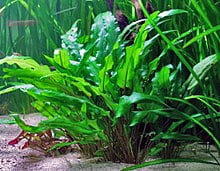Cryptocoryne

Cryptocoryne is a genus of aquatic plants from the family Araceae. The genus is naturally distributed in tropical regions of India, Southeast Asia and New Guinea.[1]
The typical habitats of Cryptocoryne are mostly streams and rivers with not too rapidly flowing water, in the lowland forest. They also live in seasonally inundated forest pools or on river banks submerged only at high water. Although the proper scientific name of the genus is Cryptocoryne, they are commonly referred to as crypts. The English name “water trumpet” refers to their inflorescence, a spadix enclosed by a spathe (typical for the whole family), which resembles a trumpet.
The first Cryptocoryne species was described in 1779 as Arum spirale by Retzius. The genus was described by Friedrich Ernst Ludwig von Fischer in 1828. However, the scientific classification of Cryptocoryne species is very complicated and there are different opinions about it. Lagenandra is another genus closely related to the genus Cryptocoryne. The two can be easily told apart since the leaves of Cryptocoryne species exhibit convolute vernation whereas Lagenandra species exhibit involute vernation.
The name Cryptocoryne is derived from the Greek crypto, hidden, and koryne, meaning club. The common name (water trumpet) refers to the shape of its inflorescence, which is typical of the Araceae family.
